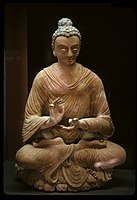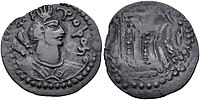 View of the Fondukistan monastery on top of a conical mountain next to the Ghorband Valley, taken by French archaeologists Joseph Hackin (1886–1941) and Jean Carl (? - 1941), during their excavation campaign from 1933 to 1940. View of the Fondukistan monastery on top of a conical mountain next to the Ghorband Valley, taken by French archaeologists Joseph Hackin (1886–1941) and Jean Carl (? - 1941), during their excavation campaign from 1933 to 1940. | |
    | |
| Coordinates | 34°58′11″N 68°52′37″E / 34.969591°N 68.876891°E / 34.969591; 68.876891 |
|---|---|
| Type | Monastery |
The Fondukistan monastery was a Buddhist monastery located at the very top of a conical hill next to the Ghorband Valley, Parwan Province, about 50 kilometers northwest of Kabul. The monastery dates to the early 8th century CE, with a terminus post quem in 689 CE obtained through numismatic evidence, so that the Buddhist art of the site has been estimated to around 700 CE. This is the only secure date for this artistic period in the Hindu Kush, and it serves as an important chronological reference point.
Characteristics
According to Benjamin Rowland "These little shrines, densely packed with sculptured figures set off by gaily painted backgrounds, must have given the effect of a kind of religious peep-show, in which, as on a stage, the visitor obtained a glimpse of celestial realms".
The works of art of the Fondukistan Monastery corresponds to a relatively high level of artistic activity in the areas controlled by the Buddhist Turk Shahis during 7-8th centuries CE, as a result of the continued development of Buddhist art, with possible Hephthalite influence, combined with the Sasanian cultural heritage. The art of Fondukistan also corresponds to the last stages of Greco-Buddhist art in the 7-8th century CE.
During this period, the Chinese Tang Empire extended its influence and promotion of Buddhism to the Kingdoms of Central Asia, including Afghanistan, with a corresponding influx of Chinese monks, while there was conversely a migration of Indian monks from India to Central Asia, precisely looking for this protection. These events gave rise to the hybrid Indian-Sinicized styles of Fondukistan and Tapa Sardar. Similarities have also been noted with contemporary works of art in China, such as those of Tianlongshan.
Discovery
Charles Masson visited the area of the Ghorband Valley in 1836 and mentioned the presence of numerous ruins in his book Narratives of various journeys in Afghanistan, Baluchistan & the Punjab.
The monastery was excavated in 1936 by Joseph Hackin of the Délégation archéologique française en Afghanistan, and in 1937 by Jean Carl, from the same organization. Most of the works of art that were recovered were shared between the Musée Guimet, Paris, and the National Museum of Afghanistan, where many did not survive the depredations of the recent decades.
Buddhist figures
-
 Seated Buddha, Fondukistan. National Museum of Afghanistan.
Seated Buddha, Fondukistan. National Museum of Afghanistan.
-
 Seated Bodhisattva, Fondukistan monastery, circa 700 CE. Kabul Museum
Seated Bodhisattva, Fondukistan monastery, circa 700 CE. Kabul Museum
-
Statue of a Bodhisattva, Fondukistan. Circa 700 CE
-
 Statue of the Buddha wearing the Iranian three-pointed chamail, Ghorband valley, Fondukistan monastery, circa 700 CE.
Statue of the Buddha wearing the Iranian three-pointed chamail, Ghorband valley, Fondukistan monastery, circa 700 CE.
-
Naga kings, Ghorband valley, Fondukistan monastery, circa 700 CE
-
 Female bust, Fondukistan. Musée des arts asiatiques Guimet.
Female bust, Fondukistan. Musée des arts asiatiques Guimet.
-
 Painting of Maitreya Bodhisattva, Fondukistan, Afghanistan, circa 700 CE. National Museum of Afghanistan.
Painting of Maitreya Bodhisattva, Fondukistan, Afghanistan, circa 700 CE. National Museum of Afghanistan.
-
Seated Buddha, circa 700 CE
Central Asian figures

Various figures from the monastery show Central Asian influence, with dignitaries wearing double-lapel caftan, boots, armour and crown with lunar crescents.
Dedications including coins of the Buddhist Turk Shahis (7-8th century CE) have been found under a statue of a royal couple in the monastery of Fondukistan, providing important insights in terms of datation. The coins were found in a cremation urn buried under the statues of the royal couple: the urn contained one Sasanian coin of the type of Khusrow II (r.590-628 CE) with Arabic "Bismillahi" legend and local countermarks, indicating a final strike date of 686 CE, thus suggesting a date soon after 686 CE for the construction of the site; another gold bracteate with the portrait of a ruler; and three early copper coins of the Turk Shahis (Göbl Type 236) with the Bactrian script legend "Srio Shaho" (![]() ).
).
The royal couple consists of a princess in "Indian" dress, and a prince "wearing a rich caftan with double lapel and boots" characteristic of Central Asian clothing.
-
 Royal couple. The King wears a Central Asian caftan with double lapel, as well as boots, while the Queen is of Indian type. circa 700 CE.
Royal couple. The King wears a Central Asian caftan with double lapel, as well as boots, while the Queen is of Indian type. circa 700 CE.
-
 Coin of Turk Shahi ruler Barha Tegin, in the style of the former Nezak Huns, of the type found in the urn of the Fondukistan monastery (Göbl Type 236). On the obverse, new legend in the Bactrian script: "Srio Shaho" ("Lord King")
Coin of Turk Shahi ruler Barha Tegin, in the style of the former Nezak Huns, of the type found in the urn of the Fondukistan monastery (Göbl Type 236). On the obverse, new legend in the Bactrian script: "Srio Shaho" ("Lord King")  . Late 7th century CE.
. Late 7th century CE.
-
 A portrait of the first Turk Shahi ruler Barha Tegin, around the time the Fondukistan Monastery was established.
A portrait of the first Turk Shahi ruler Barha Tegin, around the time the Fondukistan Monastery was established.
Notes
References
- Brendan, Cassar; Sara, Noshadi; Kabul, UNESCO Office (31 December 2015). Keeping history alive: safeguarding cultural heritage in post-conflict Afghanistan. UNESCO Publishing. p. 106. ISBN 978-92-3-100064-5.
- "Images of the Fondukistan monastery". Colorado State University.
- Verardi, Giovanni; Paparatti, Elio (2005). "From Early to Late Tapa Sardār: A Tentative Chronology". East and West. 55 (1/4): 432. ISSN 0012-8376. JSTOR 29757657.
- ^ Novotny, Susanne (1 January 2007). "The Buddhist Monastery of Fondukistān, Afghanistan – A Reconstruction". Journal of Inner Asian Art and Archaeology. 2: 31–37. doi:10.1484/J.JIAAA.2.302542. ISSN 1783-9025.
- Rowland and Rice, Ancient Art of Afghanistan, p. 45
- ^ "FONDOQESTĀN – Encyclopaedia Iranica". iranicaonline.org.
- Compareti, Matteo (2008). "The Painting of the "Hunter-King" at Kakrak: Royal Figure or Divine Being?". Studio Editoriale Gordini: 133.
- ^ Verardi, Giovanni; Paparatti, Elio (2005). "From Early to Late Tapa Sardār: A Tentative Chronology". East and West. 55 (1/4): 437–438. ISSN 0012-8376. JSTOR 29757657.
- "Stylistic similarities between the images of Fonduqistan and late Tapa Sardar and the early 8th-century Tang production of Tianlongshan have been noted, and the existence of a 'common international style' inclusive of Tang China and the regions to the west and south of the Pamir has been suggested" in Verardi, Giovanni; Paparatti, Elio (2005). "From Early to Late Tapa Sardār: A Tentative Chronology". East and West. 55 (1/4): 433. ISSN 0012-8376. JSTOR 29757657.
- Naweed, Hamid (28 February 2013). Art Through The Ages in Afghanistan. Author House. pp. 239–240. ISBN 978-1-4817-4275-7.
- Masson, Charles (1842). Narrative Of Various Journeys In Balochistan Afghanistan And The Panjab Vol III. p. 169.
In the valley of Ghorband, separated from Koh Daman to the west by a high hill range stretching from the Hindu Kosh, are many and important remains of ancient times....
- "Encyclopaedia Iranica: Fondukistan". iranicaonline.org.
- Novotny, Susanne (1 January 2007). "The Buddhist Monastery of Fondukistān, Afghanistan – A Reconstruction". Journal of Inner Asian Art and Archaeology. 2: 31–37 and this page, also this page. doi:10.1484/J.JIAAA.2.302542. ISSN 1783-9025.
- Compareti, Matteo (2009). "Iranian Elements in Kaśmīr and Tibet Sasanian and Sogdian Borrowings in Kashmiri and Tibetan Art". Transoxiana. 14.
- Hackin, J. (1938). "Les travaux de la Délégation archéologique française en Afghanistan: COMPTE-RENDU SOMMAIRE (SEPTEMBRE 1936-AOÛT 1937)". Revue des arts asiatiques. 12 (1): 10–11. ISSN 0995-7510. JSTOR 43475079.
- Hackin, J. (1938). "Les travaux de la Délégation archéologique française en Afghanistan: COMPTE-RENDU SOMMAIRE (SEPTEMBRE 1936-AOÛT 1937)". Revue des arts asiatiques. 12 (1): 10–11. ISSN 0995-7510. JSTOR 43475079.
- ALRAM, MICHAEL (2014). "From the Sasanians to the Huns New Numismatic Evidence from the Hindu Kush" (PDF). The Numismatic Chronicle. 174: 282–285. ISSN 0078-2696. JSTOR 44710198.
- For the photograph of the famous statue, named the "Royal Couple of Fondukistan", see: "FONDOQESTĀN – Encyclopaedia Iranica". iranicaonline.org.
- Kuwayama, Shoshin (1976). "The Turki Śāhis and Relevant Brahmanical Sculptures in Afghanistan" (PDF). East and West. 26 (3/4): 399–400. ISSN 0012-8376. JSTOR 29756318.
- ALRAM, MICHAEL (2014). "From the Sasanians to the Huns New Numismatic Evidence from the Hindu Kush". The Numismatic Chronicle. 174: 282–283. ISSN 0078-2696. JSTOR 44710198.
- "Fondukistan Digitaler Ausstellungskatalog". pro.geo.univie.ac.at. Kunsthistorisches Museum Vienna. Archived from the original on 2020-09-22. Retrieved 2020-11-01.
- Hackin, J. (1938). "Les travaux de la Délégation archéologique française en Afghanistan: COMPTE-RENDU SOMMAIRE (SEPTEMBRE 1936-AOÛT 1937)". Revue des arts asiatiques. 12 (1): 10–11. ISSN 0995-7510. JSTOR 43475079.
- Hackin, J. (1938). "Les travaux de la Délégation archéologique française en Afghanistan: COMPTE-RENDU SOMMAIRE (SEPTEMBRE 1936-AOÛT 1937)". Revue des arts asiatiques. 12 (1): 10–11. ISSN 0995-7510. JSTOR 43475079.
- Alram, Michael; Filigenzi, Anna; Kinberger, Michaela; Nell, Daniel; Pfisterer, Matthias; Vondrovec, Klaus. "The Countenance of the other (The Coins of the Huns and Western Turks in Central Asia and India) 2012-2013 exhibit: 12. ZABULISTAN: FROM THE ALKHAN-NEZAK CROSSOVER TO THE TURKS". Pro.geo.univie.ac.at. Kunsthistorisches Museum Vienna. Archived from the original on June 23, 2017. Retrieved July 16, 2017.
- A recent detailed view: "Les trésors sataniques - Satanic treasures PATRICK CHAPUIS PHOTOGRAPHE". patrickchapuis.photoshelter.com. Archived from the original on 2022-01-06. Retrieved 2020-11-01.
- Alram 2014, p. 282, Plate 43 coin number 37.
Sources
- Alram, Michael (2014). "From the Sasanians to the Huns New Numismatic Evidence from the Hindu Kush". The Numismatic Chronicle. 174: 261–291. JSTOR 44710198. (registration required)
- J. Hackin, "Le monastère bouddhique de Fondukistan (fouilles de J. Carl, 1937)," MDAFA 8, 1959, pp. 49–58.
- J. Hackin, "The Buddhist Monastery of Fondukistan," Afghanistan (Kabul) 5/2, 1950, pp. 19–35.
External links
- Photographs from the original reports by J. Hackin Archived 2015-07-17 at the Wayback Machine
| History of Central Asia | |||||||||||||||||||||
|---|---|---|---|---|---|---|---|---|---|---|---|---|---|---|---|---|---|---|---|---|---|
| Polities |
| ||||||||||||||||||||
| Culture | |||||||||||||||||||||
| Archaeology |
| ||||||||||||||||||||
| Artifacts |
| ||||||||||||||||||||